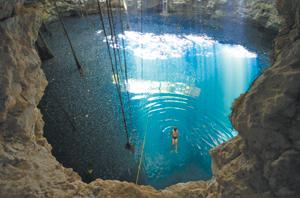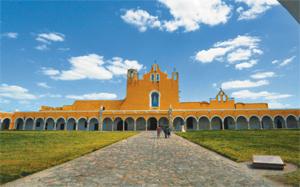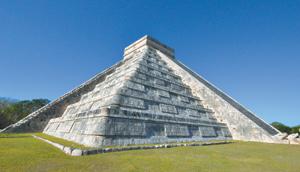
Underground water pools, or cenotes, are dramatic and refreshing spots for a swim. Credit: David Walberg

The bright-yellow town of Izamal has a rich colonial heritage. Credit: David Walberg
The seaside pleasures of Mexico’s Yucatán peninsula are well documented. From the party hub, Cancún, a strip of soft white sand runs almost uninterrupted through the resorts of the Mayan Riviera and the gay-friendly town of Playa del Carmen all the way to the Mayan ruins at Tulum. The area is well travelled and well developed — some say overdeveloped, although Riviera resorts must be no more than three storeys high, so as not to poke above the tallest palm trees in the landscape.
But the true treasures of the region are to be found inland, away from the sprawling resorts and hotels, as either an accompaniment or an alternative to a beach vacation. Here are five reasons to get off the beach and head for the interior.
1 – Ancient Mayan ruins
The Yucatán was an important centre of the ancient Mayan world during its heyday. The famous ruins of Chichen Itza are here, but so are many other ancient Mayan settlements. Ek Balam is a sprawling archeological site notable for its intact, intricate temple carvings and for the fact that one can still ascend the temple stairs for a breathtaking view of the entire site and the Yucatán beyond. Many sites have closed their temple stairs to visitors to help with preservation. Uxmal, one of the best-preserved Mayan sites, boasts two monumental stepped pyramids and a quadrangle enclosed by striking cut-stone buildings.
2 – Contemporary culture
The provincial capital, Mérida, and the towns of Valladolid and Izamal are cultural hubs. Markets are a lively jumble of local handicrafts, produce and cuisine, while town plazas host local musicians, dancers and vendors. In the countryside, small workshops open their doors, allowing visitors to meet and watch the artisans at work.
The Haciendas of the Mayan World Foundation supports rural artisans in reclaiming traditional Mayan techniques while promoting self-sufficiency, environmental sustainability and fair trade. The foundation is the philanthropic arm of Grupo Plan, a real estate developer that has overseen the restoration of several haciendas. In the Santa Rosa community, visitors can drop in at the cooperative workshops of skilled artisans who produce high-quality textiles, jewellery and handicrafts. It’s a unique chance to witness an inspiring community initiative while doing some one-of-a-kind shopping.
3 – Fresh water
Yucatán province is almost entirely flat and contains not a single surface river or lake. But fresh water can be found in the cenotes (se-NO-tays), or underground water pools, the remnants of river systems that now sit at the bottom of caves.
On a hot sunny day, nothing is more refreshing than a descent below ground where the air is fragrant and cool. Maya Moon Tours, which specializes in gay tours of the region, and Catherwood Travels offer noteworthy visits to the cenote Xchen, near the town of Valladolid. The cave is particularly deep, with openings above where the surface ground has collapsed into the cavity. These natural skylights allow sunlight to illuminate the space and stream dramatically onto the water.
A dip in the fresh waters is an invigorating alternative to an afternoon siesta. At Xchen, you can sip on a Mexican beer while you swim and enjoy an outdoor lunch under the trees afterwards. There is a confluence of cenotes in the north Yucatán around the rim of the Chicxulub crater, believed by some to be the site of the meteor impact that felled the dinosaurs 65 million years ago.
Over on the Gulf Coast, the fresh water of the Celestún estuary creates a unique ecosystem where it combines with seawater off the Gulf in a huge mangrove forest. The area is preserved as the Celestún Biosphere Reserve – even cellphones are banned for fear of disturbing the huge flocks of exotic birds that migrate here, most famously flamingos but also herons and pelicans, among 300 identified species.
The reserve also provides food and shelter for sea turtles, crocodiles, iguanas and boa constrictors. Boat tours are the best way to see the wildlife and enjoy a swim in one of the freshwater springs that bubble up in the estuary. The fishing town is home to restaurants that celebrate the local seafood, and the surrounding beaches are clean and free of crowds.
4 – Colonial architecture
The Yucatán is home to some of the oldest colonial buildings in the Americas.
Mérida’s Catedral de San Ildefonso, completed in 1596, is the oldest on the continent. It contains a black Jesus — a symbol of the Catholic Church’s early practice of globalization, by which the hesitant Mayans were lured into the imperial religion with icons that reflected their appearance and stories that incorporated local myth. The colonial city of Izamal is famous for the sunshine yellow paint that blankets the town. The Franciscan monastery is the central attraction; completed in 1561, the vast complex sits atop an ancient pyramid.
5 – Historic haciendas
For a brief period at the dawn of the 20th century, the Yucatán was the wealthiest region in Mexico. Sisal, the fibre made from agave plants, was in big demand through both World Wars, and its production made millionaires of plantation owners in the province. European architects were hired to convert the plantations into grand haciendas, or estates, most of which were abandoned as the wars were won and synthetics were invented.
A number of the haciendas have been restored as hotels — some luxurious, some rustic — that benefit from these opulent, self-enclosed settings.
The Hacienda Santa Rosa is a charming, remote location for a unique retreat. It features the best of original hacienda design: grand buildings, sprawling terraces, vast gardens and a variety of private areas for rest and contemplation. Suites are spread amongst the grounds in individual buildings with outdoor plunge pools and private patios. The outdoor swimming pool flows into a cavern to provide respite from the midday sun. Expansive covered terraces provide opportunities to socialize — the elegant front promenade, with its long row of Roman arches and columns, is ideal for evening cocktails; the back patio houses the restaurant. The Santa Rosa is a great base for visiting the local artisanal cooperative workshops and the nearby Uxmal archeological site.
Even in the busy capital of Mérida, La Hacienda Xcanatún feels like a country retreat. The beautiful original buildings are set amongst nine acres of lush gardens and two swimming pools. Suites open their oversized carved cedar doors onto terraces overlooking the greenery, providing a restorative urban oasis and a glimpse into hacienda living of the past. The restaurant, Casa de Piedra, occupies the converted historic processing facility, its 30-foot ceilings dramatically punctured with modern skylights. It features a cool piano bar and is consistently rated as one of the best restaurants in Mérida.

 Why you can trust Xtra
Why you can trust Xtra